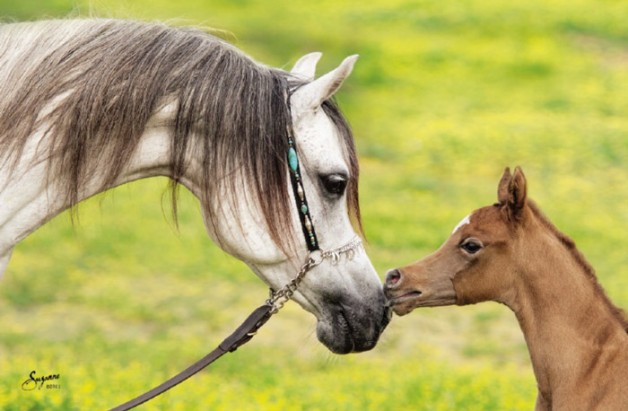HOW best to boost the number of Arabian horses in competition was a hot topic at the first conference during this year’s World Arabian Horse Racing Conference in Warsaw, Poland, on Thursday.
Asked by Derek Thompson, who was moderating the talk on breeding, how more and better Arabian horses could be produced, Michelle Morgan, a leading figure in Arabian racing in America, spoke about making the pursuit more accessible.
“In the US we asked what could we do to promote breeding, as the numbers were down,” she said.
“We asked studs whether they would lower stud fees. Sheikh Mansoor bin Zayed Al Nahyan [deputy prime minister of the UAE, a leading Arabian horse owner and sponsor of the event] has given so much to the industry, and by lowering their fees my clients haven given something back too. As a consequence, last year the number of Arabian horses we bred tripled.
“Many breeders said they had dreamt of breeding to some of the wonderful stallions and now, finally, they could.
“Sometimes I hear people say ‘if you can’t afford to breed you shouldn’t do it”, but that’s wrong; everyone needs to be involved in the Arab horse. When California Chrome [bred by small-time owners who bought the dam for just $8,000] won the Kentucky Derby, everyone went crazy – the public loves the underdog.”
Stud fees are not an issue in the UAE, where some stallions stand for free, and Khalid Al Naboodah, a leading breeder in the country, stressed that culling was important for improving the breed.
“Covering mares with just any stallion is no good,” he said. “You need to study the pedigrees of the sire and dam and consider what distance you want the progeny to run over.
“And why keep lines where there have been no winners in two or three generations? Let them go!”
Dr Andrew Dalglish, senior vet for Al Wathba Endurance Stables and Stud, said the use of artificial insemination allowed for Arabian horses to be bred more cheaply.
“Using frozen semen is cheaper and gives us the opportunity to increase the number of horses we produce, and can lead to better breeding,” he said.
Morgan also suggested breeders’ premiums were a good incentive for breeding more horses, while Manuela Daverio of Germany – breeder of Ameretto, the first purebred Arabian horse to win the Sheikh Zayed bin Sultan Al Nahyan Cup Triple Crown three years in a row – said those premiums allowed breeders to reinvest in better matings.
Dalglish sounded a note of caution, saying: “We shouldn’t necessarily be looking at mating plans on cost, we should be aiming to produce the best stock.”
The debate turned to the contentious topic of embryo transfer in Arabian horse breeding, whereby a mare conceives a foal but the embryo is then donated to a surrogate dam who carries the foal to term and delivers it.
In that method of breeding – strictly forbidden for thoroughbreds, where a stallion has to impregnate the dam by covering – one mare could be the genetic mother of several offspring within the space of a year.
Marek Trela, director of Janow Podlaski State Stud in Poland, explained that individual Arabian racing authorities across the world set different limits on the number of foals a mare could be mother to genetically. In Poland a mare can produce only one foal by embryo transfer and another by natural birth.
Trela said he was still unsure of the merits of embryo transfer, citing a colleague who had seen at a stable “seven bad geldings born in one year from one mare”.
Daverio advocated the use of embryo transfer in specific cases, when a mare has trouble reproducing naturally.
“You have to protect your best mares and the dam of Ameretto has a placenta retention problem, so we have to use embryo transfer. But there have to be rules to control the practice – for producing certain foals it is okay, but in other cases it is not.”
French breeder Catherine Labarthe, responsible for champion Djainka Des Forges, was in general agreement with Daverio.
“If a mare is old and can no longer reproduce naturally, why not [use embryo transfer],” she said. “It can be very advantageous as mares are fragile, but it should be better regulated. We have to be careful of breeders who will produce too many foals from one mare.”
Al Naboodah advocated a limit of two foals per season born by embryo transfer, although Dalglish was less sure, saying: “There should be a limit, but how many? The technology is not straightforward. You couldn’t produce ten, but you could produce three, and why not?
“The example of seven bad geldings from one mare: that could be an advantage, as otherwise you would have had to wait seven years to find out the mare was producing bad offspring.”
Dalglish highlighted that embryo transfer meant the environmental issues surrounding the surrogate dam were important – she would have to be capable of producing good milk and have a good character as the foal would be influenced by that.
Responding to a question later in the session, Dalglish said: “We [Arabian racing] need to increase the number of good horses we have in a short time, to build for the future. Embryo transfer speeds up the production of quality horses.”
A straw poll of delegates for the conference on breeding showed that the majority were in favour of embryo transfer with a limit of foals from one mare in a year.



